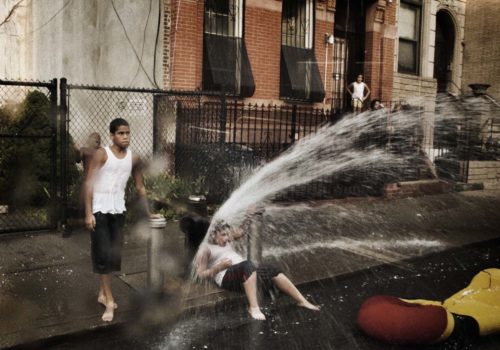Brooklyn is country. It is the country of the greatest city in the world. It is the place where New York’s energy stops for a breath and exhales itself back into the Universe. It is the place where all the vibrations of Manhattan resonate at their own frequency. It is a place that is at once wholly itself, unlike any other energy on earth.
Brooklyn Buzz (Damiani) is by Gaia Light and Alessandro Cosmelli, take us on a stroll up and down the avenues and across the side streets and on the sidewalks and stoops and anywhere there is public life. The book is beautifully produced, four-color photographs on uncoated paper, creating both a raw and unvarnished glimpse at this energy, while also mediating its sharp edges.
The denseness of the color and the images is sustained by the way the action and non-action they capture. There is a double page spread of a neon sign that says “Psychic,” which recalls a certain je ne sais quoi to these images. There are the people and their spirit, and then the energy that is in the air, and as that blends as the camera lens softens its focus, the photographers successfully capture the feeling of what’s in the air.
Life is hectic but slow, measured at a pace that defines itself. To live and work in Brooklyn is to have access to all that is New York without ever getting swept away. And though life is slower that does not mean it is less intense. The people of Brooklyn have their own flow. They walk and skate and drive and ride the trains, taking care of just what needs to be done.
Brooklyn Buzz beautifully captures the subtleties of life on the street and the way in which we share this world. It overwhelms through emotion but not through action, like the close up of an older couple holding hands. WE see nothing except their hips and hands clasped as they likely have for decades past, and what we feel is the unity between each other, and the unity that is what Brooklyn does best.
It is here you belong, exactly as you are. There is none of the posturing and posing and jockeying that makes Manhattan the playground of the world. There is a pose, a certain stance, but it is not one that errs on the side of urbane sophistication (whether falsely or accurately created by Manhattan’s self-conscious inhabitants). Rather, in Brooklyn, there is a pose and it is one of resolution, commitment and strength. It is a perseverance, a sense of humor, a self awareness that says, “Fugghedaboudit.”
Reflecting the same vibe, albeit at a different place and a different time, is Robert Doisneau’s Paris Les Halles Market (Flammarion), which takes us deep into a world that had its own rules. As Doisneau recollects in the book’s forward, drawn from his personal notebooks: “”I was a harmless photographer, considered mildly obsessed. I didn’t understand these technocrats’ ideas with their “geometric” goals labeled profitably, specialization, division of labor, and efficiency. All of this was in diametric opposition to everything I came to Les Halles at night to seek, everything I was trying to picture…
“Paris is losing it’s ‘belly’ and much of its spirit. I couldn’t care less about night-owls in search of a breath of fresh air after their debauched nocturnal pleasures, but I worry about the drifters, without friends in a sleeping city where telephones are silent; if one of them drifted into Les Halles, with a little luck he’d find something to keep him going. With a little more luck, he’d be adopted. This is no legend, but a true story that has been quietly repeated a hundred times in bistro conversations….
“But to get back to Les Halles: the market had occupied the site for nine hundred years. Long enough for people to get used to it. Closing it down would risk sparking disgruntlement among the good people of Paris. So the public authorities raised the spectre of rats…. On the morning they shut the market down, you could see the street cleaners clothed from head to toe in white, roaming the neighborhood with buckets of poisoned wheat in each hand, and followed by a pack of photographers.”
Because, as Doisneau’s photographs so effortlessly behold, this was the ever end, the end of not only a way of life but an identity that had shaped the mindset of a place. We are defined by where and how we live and Les Halles, as Doisneau shows us, was a distinctive organism unto itself. It drew people in, and set them afoot to peruse and parade and set a pace upon a path that would take them through the great marketplace, the grand bazaar, the shops and goods and wares and the wear-bearers, the workers keeping pace, delivering that which is part of each and every life.
A man walking the street with a small fawn laced up, slung over his shoulder as his hand grips the hind legs of a large rabbit. Shot in 1968, called Early Morning Game, this image reveals the natural balance between city and country living. Les Halles was the site of where the two met, all these paths crossing, interesting, and then going about their business, on to the next, such as it is.
Miss Rosen
















